
Pair Thinking with AI: How to Use ChatGPT as Your Research Partner
Pair Thinking with AI: How to Use ChatGPT as Your Research Partner
TL;DR: Pair thinking with AI means turning an AI into a live collaborator while you research. You externalize your thinking, iterate hypotheses, and get critiques in real time—so your attention stays on judgement and originality.
Not outsourcing thinking, offloading mechanics (summarization, recall, reframing) so you can think better, faster, and more clearly.
What is “pair thinking with AI”?
Research is messy: half‑formed hypotheses, tentative links, and occasional dead ends. Pair thinking with AI is a practice where you narrate your thinking to an AI (e.g., ChatGPT or an AI notepad) while you work. The AI asks follow‑ups, proposes counter‑arguments, and keeps track of fragments so you don’t have to.
- You stay in the driver’s seat; AI handles grunt work.
- You externalize thoughts into text the AI can probe.
- You iterate quickly: summarize → hypothesize → challenge → synthesize.
Why externalizing thoughts helps
Putting ideas into sentences forces clarity. An AI partner accelerates that clarity by:
- Asking clarifying questions you may not think to ask yourself
- Surfacing missing evidence and alternative framings
- Keeping persistent memory of clips, references, and rationales
- Turning raw notes into structured claims, pros/cons, and next steps
Quick start
- Create a running note. Drop in quotes, links, and gut reactions as you read.
- Declare your goal. e.g., “I’m researching X to decide Y by Friday.”
- Narrate your steps. Ask the AI to summarize, compare, or critique as you go.
- Log decisions. Capture why you accepted or rejected evidence.
Using Notes – reconfigured? It ties your notes to a latest best AI models so you can capture, iterate, and synthesize in one place, without copy/paste round‑trips. Try Notes – reconfigured.
AI research workflow: step‑by‑step
1) Capture
While reading, clip short excerpts and paste quick impressions into your note.
- Tag with intent:
investigate,cite,contradict,discard. - Keep source links next to each clip.
Prompt
I’m researching <topic>. Here are new clips with links:
<clips>
Tag each clip as investigate/cite/contradict/discard and note one implication.
2) Summarize
Turn the clutter into compact insights.
Prompt
Summarize these clips into 3–5 insights, each with a one‑sentence rationale and one open question.
3) Hypothesize
Draft a working claim you can test.
Prompt
Based on the summary, propose 1 primary hypothesis and 2 alternative hypotheses.
For each, list: key assumptions, strongest supporting evidence from the clips, and a falsifier.
4) Challenge (devil’s advocate)
Stress‑test the claim to avoid confirmation bias.
Prompt
Play devil’s advocate against the primary hypothesis. Provide:
• 3 plausible counterarguments
• 3 missing data points or sources to check
• 2 alternative causal explanations
5) Synthesize
Convert your exploration into a short memo or draft section.
Prompt
Draft a 300–500 word synthesis that states the hypothesis, strongest evidence, key uncertainties, and recommended next steps. Include an outline for a longer report.
6) Decide next actions
Create a small, prioritized research backlog.
Prompt
Turn our discussion into a prioritized checklist with owners, rough effort (S/M/L), and links to the relevant clips.
Prompt recipes (copy‑ready)
- Insight compressor
Summarize these notes into 3 concise findings and 2 open questions that would change the conclusion.
- Counterargument generator
What are 3 credible counterarguments to this hypothesis? For each, suggest one source or dataset to check and one quick test.
- Gap finder
Identify gaps or leaps in this reasoning. Recommend experiments, datasets, or expert interviews to close each gap.
- Synthesis starter
Write a structured memo with headings: Context, Hypothesis, Evidence, Caveats, Next Steps. Keep it under 500 words.
- Decision log
Convert the previous exchange into a decision log: decision, rationale, alternatives considered, date, and links.
Example: from clips to claims in 10 minutes
- Paste five article snippets and a meeting note.
- Ask: “What hypothesis do these imply? Give me one strong claim and two weaker claims, plus what evidence would falsify them.”
- Receive structured claims and a short checklist of proof.
- Tag checklist items as follow‑up and route them to your next session.
Best practices for pair thinking with AI
- Bound the scope. Timebox AI tasks and specify outputs (e.g., “3 bullets, then 1 table”).
- Stay judgement‑led. Treat AI as a collaborator; annotate results with your own take.
- Keep receipts. Save quotes and links next to claims to avoid later re‑work.
- Version your hypotheses. Add dates and status (draft/adopted/retired).
- Log why. Record rationales so future‑you remembers decision context.
Pitfalls (and how to avoid them)
- Over‑trusting AI framing. Always request competing interpretations and falsifiers.
- Hallucinations. When AI asserts facts, ask for sources or add a “to‑verify” tag.
- Confirmation bias. Make “devil’s advocate” a default step in your workflow.
- Scope creep. Keep prompts tight; break big asks into smaller steps.
FAQ: Pair thinking with AI
Isn’t this just asking ChatGPT questions? Not quite. Pair thinking is a process: capture → summarize → hypothesize → challenge → synthesize → decide. The structure is what compounds.
Can AI really help me think better, not just summarize? Yes—by asking clarifying questions, proposing counter‑arguments, and keeping a persistent trail of your reasoning so you can refine it.
Do I need a special app? You can use any AI chat, but a notes‑first tool streamlines capture and synthesis. Notes – reconfigured connects your notes to GPT‑5 so you can move from clip → claim → draft without friction. Try it here.
What about privacy? Keep sensitive data in trusted tools and redact as needed. Save links and quotes, not credentials.
Conclusion
Pair thinking with AI turns messy research into a clear, iterative dialogue. Combine your judgement with a capable partner—ChatGPT or a notes‑first tool like Notes – reconfigured—and you’ll clarify ideas faster, surface blind spots earlier, and ship better work. Ready to try it in your own workflow? Open Notes – reconfigured and start pair thinking with GPT‑5 today.